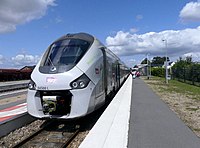
Photo from wikipedia
Fossil fuel depletion and environmental pollution are paramount problems the world faces. Despite several measures, the transportation industry is still battling to manage these issues. A combined approach of fuel… Click to show full abstract
Fossil fuel depletion and environmental pollution are paramount problems the world faces. Despite several measures, the transportation industry is still battling to manage these issues. A combined approach of fuel modification for low-temperature combustion with combustion enhancers could offer a breakthrough. Due to their properties and chemical structure, biodiesels have piqued the interest of scientists. Studies have asserted that microalgal biodiesel might be a viable alternative. Premixed charge compression ignition (PCCI) is an easily adoptable promising low-temperature combustion strategy in compression ignition engines. The objective of this study is to identify the optimal blend and catalyst measure for improved performance and reduced emissions. Microalgae biodiesel at various proportions (B10, B20, B30, and B40) was amalgamated with CuO nanocatalyst and tested to arrive at the right concoction of biodiesel with nanoparticles in a 5.2 kW CI engine for different load conditions. The PCCI function warrants that about 20% of the fuel supplied is vaporized for premixing. Finally, the interplay factors of the independent variables of the PCCI engine were then explored by response surface methodology (RSM) to determine the optimal level of desired dependent and independent variables. The RSM experiment findings suggest that the best biodiesel and nanoparticle concoctions at 20%, 40%, 60%, and 80% loads were B20CuO76, B20Cu60, B18CuO61, and B18CuO65, respectively. These findings were experimentally validated.
Journal Title: ACS Omega
Year Published: 2023
Link to full text (if available)
Share on Social Media: Sign Up to like & get
recommendations!